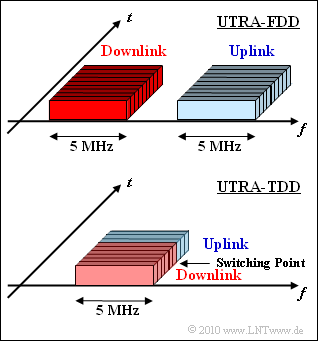Exercise 4.1: Different Duplex Methods for UMTS
Planned in the early 1990s and available in Europe since 2004 $\rm UMTS$ (Universal Mobile Telecommunications System ) is a so-called third-generation mobile communications system.
It uses in both directions - uplink and downlink - the multiple access method "CDMA" (Code Division Multiple Access).
The standardization essentially provides for two different modes:
- ${\rm UTRA\:FDD}$ (UMTS Terrestrial Radio Access Frequency Division Duplex ) with twelve paired frequency bands for the uplink $(1920 - 1980 \ \ \rm MHz)$ and the downlink $(2110 - 2170 \ \ \rm MHz)$.
- ${\rm UTRA\:TDD}$ (UMTS Terrestrial Radio Access Time Division Duplex ) provides four channels in the frequency band of $1900 - 1920 \ \rm MHz$ and another at $2020 - 2025 \ \rm MHz$.
There is currently no license for the band at $2010 - 2020 \ \rm MHz$ . However, this is also reserved for UTRA TDD.
- The diagram shows schematically the frequency band assignments of UTRA FDD (top) and UTRA TDD (bottom).
- It can be seen that the two methods are quite different both in terms of multiple access and duplex implementation.
Hints:
- This exercise belongs to the chapter "General Description of GSM".
- Reference is made in particular to the page "Full Duplex".
Questions
Solution
(1) Correct is statement 2:
- A representative of the second generation of mobile communications is "GSM" (Global System for Mobile Communications), which has been available since the early 1990s and is based on the modulation method "GMSK" (Gaussian Minimum Shift Keying) is based.
- In contrast, UMTS uses as multiple access method "CDMA" (Code Division Multiple Access).
- The fourth-generation mobile communications system is "LTE" (Long Term Evolution), which is based on the "OFDM method" (Orthogonal Frequency Division Multiplex) is based on. LTE rollout began in the early 2010s.
(2) From the graph on the statement page, you can see that for $\rm UTRA\:FDD$, the last statement is true.
(3) Correct are statements 1 and 2:
- According to the diagram below, in $\rm UTRA\:FDD$ the uplink and downlink are transmitted in the same frequency band.
- The separation is done by time division multiplexing.
(4) According to the specification, uplink and downlink occupy $60 \ {\rm MHz} each. \ \Rightarrow \ B_{\rm ges}\hspace{0.15cm}\underline{ = 120 \ \rm MHz}$.
(5) In each case $B_{\rm user} \hspace{0.15cm}\underline{ = 5 \ \rm MHz}$, both in uplink and downlink.
- This value is obtained by dividing the respective total bandwidth for uplink and downlink $(60 \ \rm MHz)$ by the number of channels $(12)$.
(6) Here again $B_{\rm user} \hspace{0.15cm} \underline{= 5 \ \rm MHz}$, but now this bandwidth must be divided between uplink and downlink by TDMA.
(7) Both statements are correct:
- There are no plans to offer $\rm TDD$ mode in Europe.
- For asymmetric service, the data volume in the downlink is significantly larger than in the uplink. Here $\rm TDD$ mode would make sense.
Examples: Surfing and downloads on the Internet.
